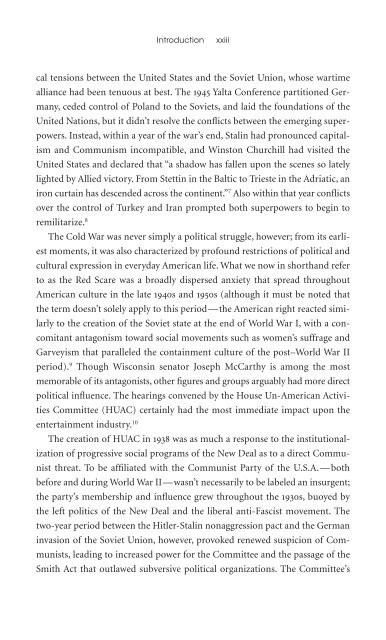Citizen-Spy
Citizen-Spy
Citizen-Spy
Create successful ePaper yourself
Turn your PDF publications into a flip-book with our unique Google optimized e-Paper software.
xii Preface<br />
matter of what historical traces opened up fruitful lines of inquiry about TV’s<br />
place within American popular culture. This book explores the continuities<br />
between television espionage programs and both official and popular discourses<br />
of national identity. In some cases the connections between TV’s fictional representations<br />
and state institutions were overt and intentional. In others, these<br />
linkages are more oblique, formed not through prescriptive policy but through<br />
common claims about national identity. The first chapter, for example, lays out<br />
the broad discursive framework of connections between official state politics<br />
and semidocumentary spy narratives in the 1950s, while the second is more<br />
narrowly focused on one program’s negotiation between documentarism and<br />
narrative. Chapter 3 explores two largely forgotten programs that scarcely can<br />
be said to have a direct influence on what followed. Their place in this history<br />
is not causal, but rather illustrative of what would turn out to be remarkable<br />
transformations in the U.S. television industry, American popular culture,<br />
and narratives of national identity in the late 1950s and early 1960s. Chapter 4<br />
addresses how parodic espionage narratives turned inward on their own discourses<br />
of national authority amid a cultural climate responsive to self-referentiality<br />
and satire. The programs discussed in chapters 5 and 6 aired largely simultaneously<br />
with the parodic programs discussed in chapter 4, and thus can’t be said<br />
to respond to the parodies in a linear or dialectic fashion indicative of a transformation<br />
in a genre. But even while the parodies exposed the vulnerability of<br />
the rigidly reductive version of nationalism that was popularized in the 1950s,<br />
other spy programs offered new realist narratives of national identity more<br />
amenable to the cultural contexts of the mid- to late-1960s America. Chapter 5<br />
explores this through the intertextual connections that linked I <strong>Spy</strong> to broader<br />
debates over civil rights and its relationship to the American national body,<br />
while chapter 6 is more industrial in focus, examining the research practices<br />
that guided the representational decisions made by a diversifying and increasingly<br />
globally minded television studio.<br />
It is in the very nature of history to exclude; the historian continually balances<br />
the equally compelling demands of breadth and depth. In navigating those demands,<br />
I have chosen to use each program as a case study of a given issue that<br />
reflects on the book’s larger arguments as a whole. The chapters of this book<br />
are thus not entirely symmetrical in approach: some draw particular attention<br />
to industrial strategies, others to matters of representation or televisual narra



